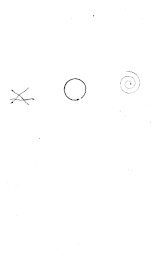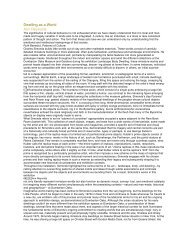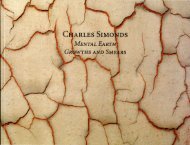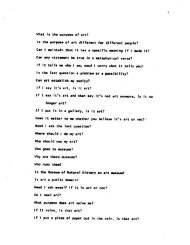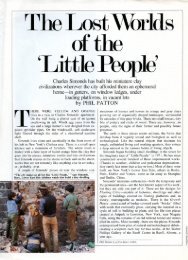Read Catalog - Charles Simonds
Read Catalog - Charles Simonds
Read Catalog - Charles Simonds
Create successful ePaper yourself
Turn your PDF publications into a flip-book with our unique Google optimized e-Paper software.
toms, justified their constructions. The freedom of the creator exists in the<br />
limits permitted him by this general acceptance. This double relation of the<br />
artist to the Dwellings and the Dwellings to the public progressively determined<br />
the major characteristics of the Little People's architecture and, initially,<br />
its tie to the sacred. Detached from all utilitarianism, the image of the<br />
city recovers its original dimension; an image that represents at the same<br />
time geomancy, translation of social structures, and delineation of religious<br />
and political positions. The differences thusly expressed are no longer based<br />
on culture but on behavior.<br />
Thus <strong>Simonds</strong> was led to distinguish in a series of sculptures and a parallel<br />
text, three fundamental categories: people who live in a line, those who build<br />
in a circle, and those who construct spirals. Each of these, more than style of<br />
urbanism, proposes a moral of existence. For the first-which <strong>Simonds</strong> experienced<br />
in his early works-the rush forward, the willingness to abandon<br />
-he wrote that "when they move, they leave everything behind, intact like<br />
a personal museum."4 Quite to the contrary, people who live in a circle live<br />
a myth of eternal return, of cyclical time, of a present inhabited by the past.<br />
Their "irreducible idea of the center/'5 is different from that of the spiral<br />
people, for whom the progression is important, despite the fact that their<br />
fanatic concern with the past links them to what they have lived. But as their<br />
Dwellings demonstrate, each in its own way, they all share the common need<br />
for a ritualized existence.<br />
At this stage, where every posture is symbolic, earth herself becomes erotic.<br />
She swells, revealing in her breast obscure analogies, unforseeable burgeonings.<br />
From 1974 on <strong>Simonds</strong>'s work has taken into account eruptions and<br />
turgidities. The constructions are no longer made on the surface of the earth,<br />
but are erected out of it, taking form from its most secret depths. The material<br />
has become gravid, and it will be revealed in time. This factor, an essential<br />
part of <strong>Simonds</strong>'s earlier work, was an intemporal time, a synthetic concept<br />
in which were mixed all the stages of the duration. With Park Model/Fantasy<br />
(pl. 26) a sort of demultiplication takes place: the same site is presented in<br />
successive phases, no one phase being pre-eminent. The identity of the site<br />
exists only through the sum of its differences, its transformations. Time reveals<br />
the true shape of things in the slow process of evolution that makes<br />
them what they are.<br />
It is with this series of Circles and Towers Growing that <strong>Simonds</strong>'s idea becomes<br />
more clearly defined. From the same common trunk emerge two possible<br />
developments, that of towers and that of circles; thus within the one<br />
family diverse faces are born from the same genes. Only destruction, effacement,<br />
eliminates these differences, returning the most elaborated of his constructions<br />
to their initial state of unformed material. The history of man is<br />
but his return to the earth, in which death traps him.<br />
<strong>Simonds</strong>'s turning away from street works to sculptures was interpreted by<br />
some as a renouncement, an integration into traditional art circles. Yet in<br />
fact his sculptures form a more elaborated part of the work in the city and<br />
lead to a symbolic dimension. Certainly his street works exist in the form of<br />
sketches, intuitive notations, and lead to sculpture, but <strong>Simonds</strong> is also advancing<br />
it as a means of contact with the outside, a touchstone of truths. The<br />
dichotomy inherent in his work, from social project to the most intimate<br />
33



